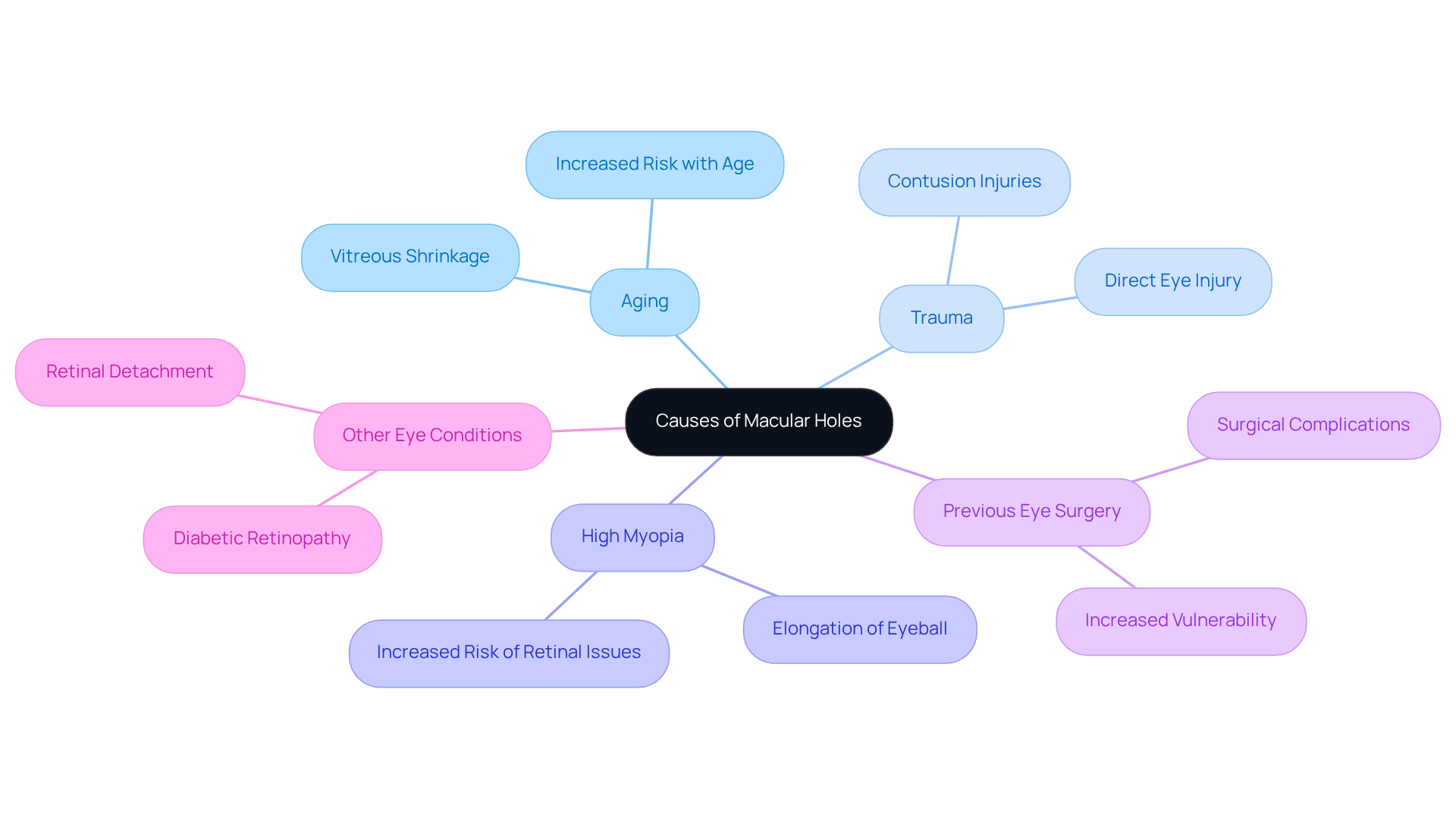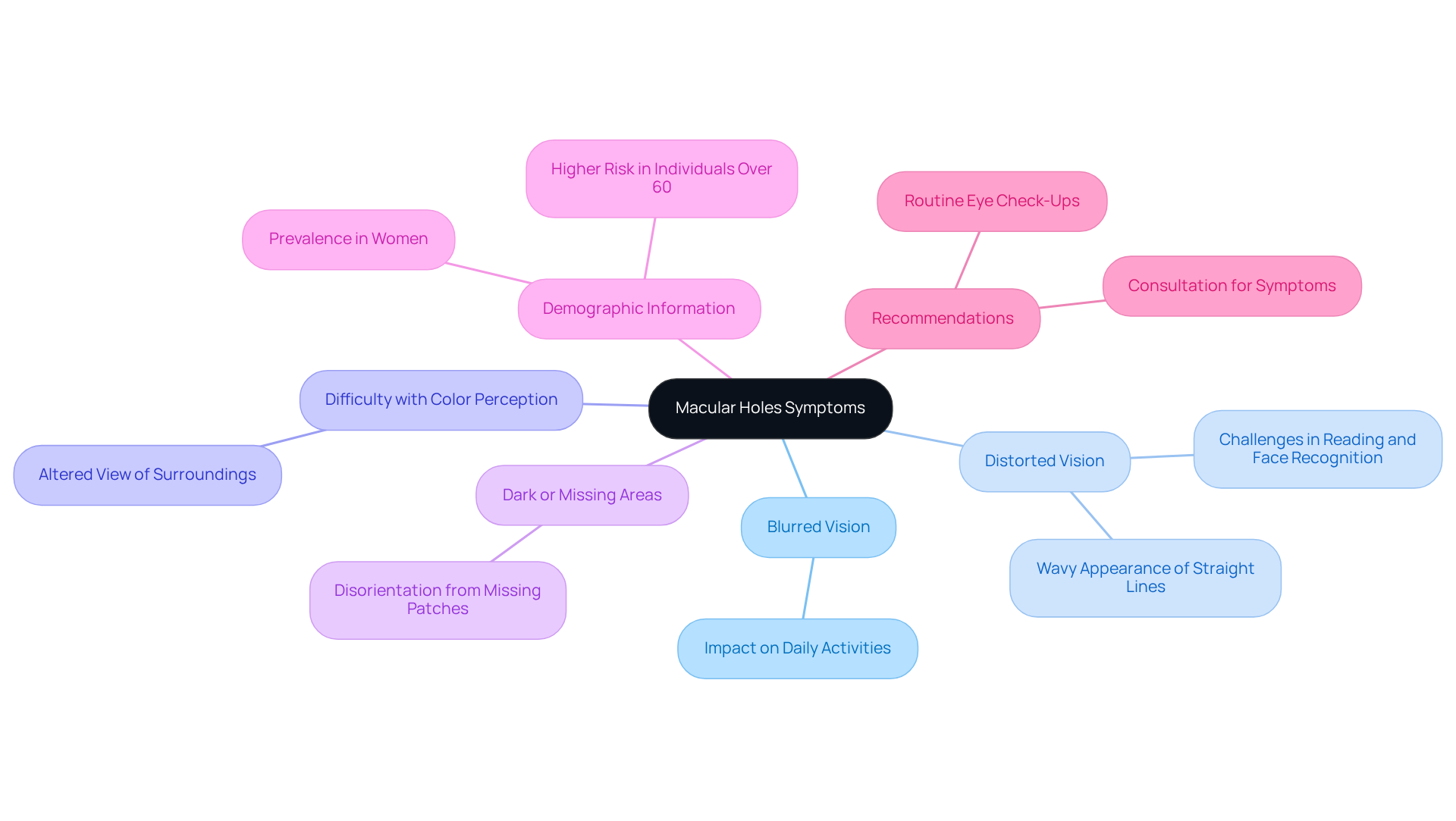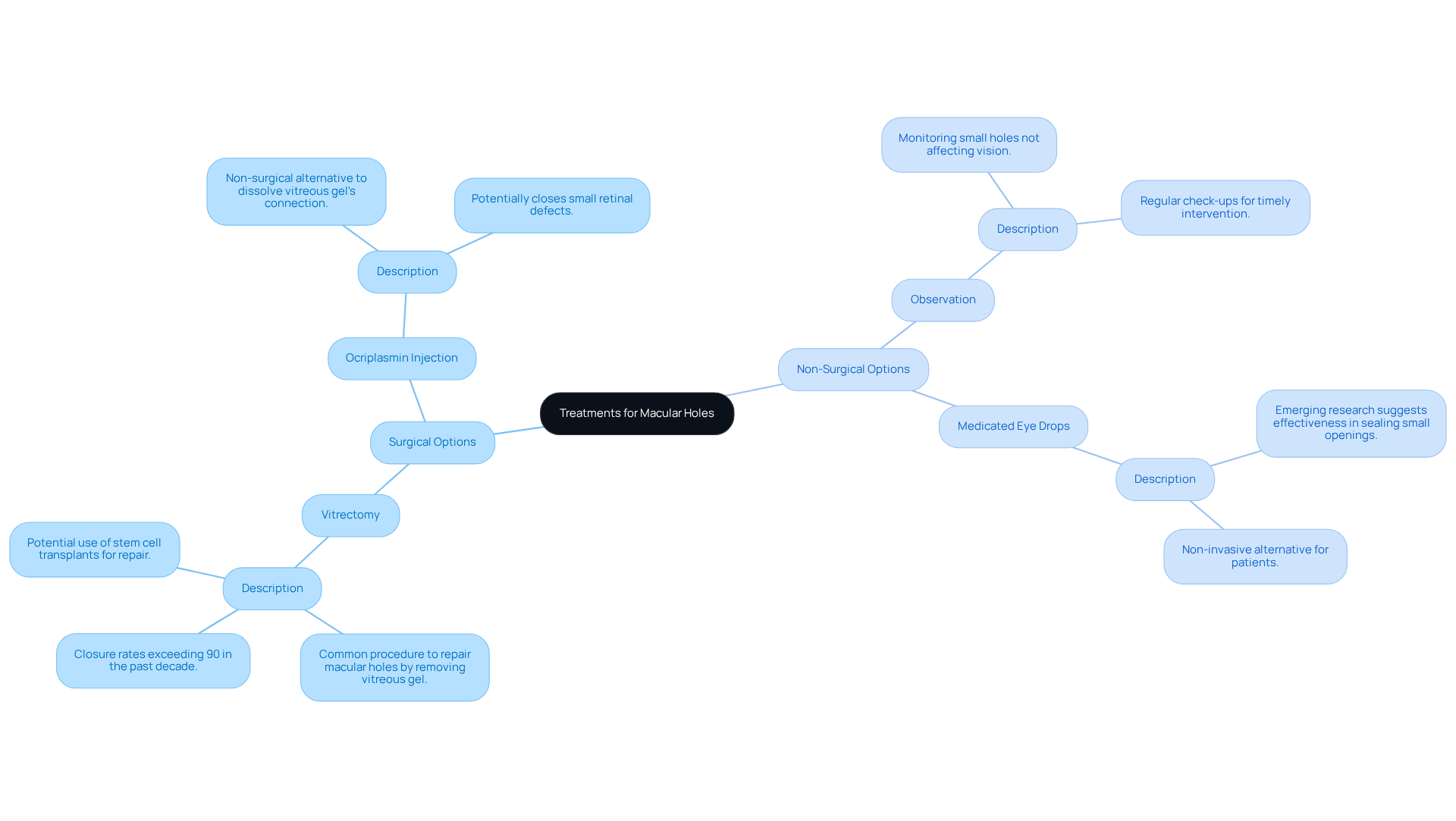Posted by: Northwest Eye in General on June 19, 2025
Overview
Macular holes are small openings in the macula that can significantly impair central vision. We understand that this condition primarily affects individuals over 60, often due to factors like aging, trauma, and certain eye conditions. It’s common to feel concerned about how this might impact your daily life.
This article provides detailed insights into the causes and symptoms of macular holes, along with effective treatment options. Surgical procedures, such as vitrectomy, and non-surgical alternatives are discussed, emphasizing the importance of early diagnosis and intervention for improved visual outcomes. We are here to help you through this process, ensuring that you feel supported every step of the way.
Remember, seeking care early can make a significant difference. Your vision is important, and there are options available to help you regain clarity and comfort in your life.
Introduction
A macular hole can profoundly affect how you perceive the world, leading to challenges in daily activities such as reading and driving. This small opening in the macula, the central part of the eye responsible for sharp vision, can develop due to natural aging or trauma, impacting individuals of all ages.
With advancements in treatment options, including surgical interventions that have high closure rates, understanding the causes, symptoms, and available treatments for macular holes is essential.
We understand that navigating this condition can be daunting, but there are steps you can take to protect your vision and find your way through these complexities.
Define Macular Holes: An Overview of the Condition
A macular hole is a tiny opening that forms in the macula, the central area of the retina responsible for clear, detailed sight. We understand that learning about this condition can be concerning. Typically, this issue arises when the vitreous gel, which fills the eye, detaches from the retina, leading to a macular hole and a full-thickness defect in the macula. The impact of retinal gaps on central vision can be significant, making daily activities like reading, driving, and identifying faces especially difficult.
Studies suggest that the occurrence rate of idiopathic retinal defects is about 8.69 eyes per 100,000 people each year, primarily affecting those over the age of 60. However, younger individuals may also experience retinal defects due to trauma or other eye conditions. Understanding the anatomy of the eye and the critical role of the macula is vital for recognizing how a macular hole can disrupt daily activities and overall quality of life.
Recent studies have shown that closure rates for smaller retinal holes, such as macular holes, can reach 100% with suitable surgical intervention, while larger holes have closure rates of 94% in face-down positioning. This emphasizes the importance of prompt diagnosis and treatment. Moreover, distorted eyesight can indicate several eye disorders, such as age-related degeneration and diabetic retinopathy. It’s common to feel anxious about these issues, making awareness essential for those at risk, especially elderly individuals and those with a history of eye injury.
At Northwest Eye, we are dedicated to patient education and understanding. We offer resources like the Eye Condition Library to empower you in managing and recognizing symptoms such as blurred vision. We encourage you to explore our resources or schedule a consultation with a Northwest Eye doctor to address any concerns regarding your eye health. Remember, we are here to help you through this process.

Identify Causes: Factors Leading to Macular Holes
Several factors can contribute to the development of macular holes, and we recognize that understanding these factors can be concerning. Here are some key factors to consider:
- Aging: This is the most significant risk factor. As we age, the vitreous gel naturally shrinks and pulls away from the retina, which can lead to issues.
- Trauma: Direct injury to the eye can result in the development of a retinal gap, and it’s common to feel anxious about such incidents.
- High Myopia: Individuals with severe nearsightedness may be at a higher risk due to the elongation of the eyeball, which can affect the retina.
- Previous Eye Surgery: Certain surgical procedures can heighten the chance of developing a retinal gap, and we want you to feel informed about your history.
- Other Eye Conditions: Diseases such as diabetic retinopathy or retinal detachment can also predispose individuals to this condition.
Understanding these causes can help in identifying individuals at risk of a macular hole and promoting . We are here to help you through this process and ensure you feel supported every step of the way.

Recognize Symptoms: How Macular Holes Affect Vision
We understand that symptoms of a macular hole can significantly affect your sight, and this can be concerning. These symptoms may vary in severity, and it’s important to recognize them early. Key indicators include:
- Blurred Vision: You may notice a gradual decline in the clarity of , which can hinder your daily activities.
- Distorted Vision: Straight lines might appear wavy or bent, complicating tasks like reading or recognizing faces.
- Difficulty with Color Perception: Changes in how you perceive colors can affect your view of the world around you.
- Dark or Missing Areas in Sight: As the condition progresses, you might see a small black patch or a ‘missing patch’ in your central vision, which can be disorienting.
Macular defects are more prevalent in women and individuals over the age of 60. They often result from aging, eye injuries, prior eye surgeries, and specific conditions like diabetes. Recognizing these symptoms early is crucial for timely intervention and treatment of a macular hole. Research indicates that 80-90% of people notice some level of enhancement in their eyesight after retinal surgery, highlighting the importance of seeking expert advice when symptoms arise.
It’s common to feel apprehensive about potential complications. One frequent post-surgical concern is retinal edema, which patients should be aware of. We recommend routine eye check-ups every one to two years, especially for those over 60, as retinal openings are more common in this age group and can lead to significant sight loss if not addressed. As one eye care expert pointed out, ‘A retinal defect occurs when there is a small rupture in the macula, potentially resulting in a macular hole, which is responsible for clear and detailed sight.’ We are here to help you through this process and ensure you receive the care you need.

Explore Treatments: Surgical and Non-Surgical Options for Macular Holes
Treatment for macular holes can be categorized into surgical and non-surgical options, each designed to help you navigate this challenging experience:
-
Surgical Options:
- Vitrectomy: This is the most common surgical procedure for repairing macular holes. It involves removing the vitreous gel to relieve traction on the retina. After this, a gas bubble may be injected to aid in sealing the gap. Recent advancements have led to closure rates exceeding 90% in the past decade, providing hope for many. Additionally, studies involving human stem cell transplants have shown promise in repairing retinal gaps, with research suggesting successful closure in a monkey model.
- Ocriplasmin Injection: If surgery feels daunting, there is a non-surgical alternative for a macular hole. This involves injecting a medication into the eye to dissolve the vitreous gel’s connection to the retina, potentially closing small retinal defects.
-
Non-Surgical Options:
- Observation: We understand that facing a diagnosis can be overwhelming. In cases where the hole is small and not significantly affecting vision, doctors may recommend monitoring the condition. Regular check-ups allow for timely intervention if necessary, providing you with peace of mind.
- Medicated Eye Drops: Recent studies suggest that specific eye drops may assist in sealing small retinal openings without surgery. This emerging research indicates a potential non-invasive alternative for patients, offering hope for those seeking less invasive options.
Understanding is essential for you to discuss with your healthcare provider, especially in relation to a macular hole, ensuring you make informed decisions regarding your eye health. As Michiko Mandai, a senior study author, noted, ‘Our results suggest that this method could become a practical, safe, and effective treatment option with minimal invasive risks, particularly for difficult cases involving a macular hole.’ We are here to help you through this process, ensuring you feel supported every step of the way.

Conclusion
A comprehensive understanding of macular holes reveals their significant impact on vision and daily life. This condition, primarily affecting older adults, can arise from various factors, including aging, trauma, and certain eye conditions. We understand that recognizing symptoms, such as blurred or distorted vision, is crucial for timely intervention. This can lead to favorable outcomes through appropriate treatments.
The article highlights the importance of awareness regarding the causes and symptoms of macular holes. It’s essential to emphasize the need for regular eye check-ups, especially for those at higher risk. Treatment options include:
- Surgical procedures like vitrectomy
- Non-surgical alternatives such as observation
- Medicated eye drops
This spectrum of choices provides effective management for this condition.
Ultimately, understanding macular holes is essential for maintaining eye health and quality of life. Those at risk should prioritize regular eye examinations and stay informed about the latest treatment options. Remember, empowerment through knowledge can lead to timely interventions, ensuring that you can continue to enjoy clear and vibrant vision.
Frequently Asked Questions
What is a macular hole?
A macular hole is a tiny opening that forms in the macula, the central area of the retina responsible for clear, detailed sight, often due to the detachment of the vitreous gel from the retina.
What causes a macular hole?
A macular hole typically arises when the vitreous gel detaches from the retina, leading to a full-thickness defect in the macula.
How does a macular hole affect vision?
A macular hole can significantly impact central vision, making daily activities such as reading, driving, and recognizing faces particularly difficult.
Who is most at risk for developing a macular hole?
The occurrence rate of macular holes is about 8.69 eyes per 100,000 people each year, primarily affecting individuals over the age of 60, although younger individuals may also experience retinal defects due to trauma or other eye conditions.
What are the closure rates for macular holes after surgical intervention?
Closure rates for smaller retinal holes, such as macular holes, can reach 100% with suitable surgical intervention, while larger holes have closure rates of 94% when the patient is in a face-down position.
What symptoms should prompt concern about a macular hole?
Symptoms such as distorted eyesight, blurred vision, or difficulty with central vision may indicate a macular hole or other eye disorders, making awareness essential, especially for those at risk.
What resources are available for patients concerned about macular holes?
Northwest Eye offers resources like the Eye Condition Library to help patients manage their eye health and recognize symptoms, as well as consultations with doctors for personalized concerns.






